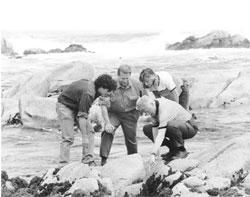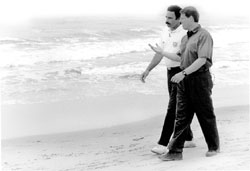
"Hope, creativity, imagination...[are] the traits that first enabled
and inspired explorers to take to the sea....In the 21st century,
these traits...must lead us to preserve our living oceans as a sacred
legacy for all time to come."
President Bill Clinton
June 12, 1998
Photo: Monterey, California, June 1998 |
Oceans sustain nearly half of all life on Earth
and, in ways we hardly realize, shape our everyday lives. Farmers in
the heartland depend on weather systems driven by the interaction of
ocean and atmosphere to nourish their crops. People who may never have
seen the ocean depend on food from its waters and energy from beneath
the seabed. Ocean-going vessels carry the bulk of our world trade, linking
us to the global marketplace and keeping our economy strong.
Increasingly, however, we have come to understand that the
"boundless" oceans have limits. They cannot provide unlimited fish, nor can
they absorb unlimited wastes from human activities. Toxic algal blooms threaten
the marine ecology and human health in many coastal areas, and unchecked
coastal development can stress ocean and coastal habitats beyond their limits.
President Clinton and Vice President Gore have launched new
actions to restore fragile coral reefs, protect our coasts from the risks of
offshore oil development, strengthen our national marine sanctuaries, and
protect dolphins and other marine mammals. And, to better address the long-term
challenges, the President and Vice President launched a national dialogue
leading to a comprehensive strategy for strengthening federal ocean policy for
the 21st century.
Protecting Critical Areas from Offshore Oil Drilling
Oil and gas recovered from undersea reserves, particularly in
the Gulf of Mexico, make an important contribution to America's energy
supply. However, long-standing concern over the inherent environmental risks of
offshore drilling have led to a series of moratoria of new oil and gas leases
off most of the U.S. coast. A five-year plan for the Outer Continental Shelf
adopted by the Administration in 1997 designated a limited number of areas for
leasing while barring new leasing off most of the coast through 2002.
To provide more lasting protection, the President issued a
directive in 1998 extending the moratorium on new offshore leasing for an
additional 10 years — through 2012. In addition, the President permanently
barred new leasing in existing national marine sanctuaries. These actions do
not affect existing leases in federal waters.
Protecting Marine Mammals
Many marine mammal species that suffered dramatic declines
through most of the 20th century are now well on their way to recovery. The
gray whale, which migrates each year from Alaska to Mexico, is no longer
classified as endangered. Humpback whales in the North Atlantic and North
Pacific are steadily recovering. And populations of the California sea lion and
Atlantic and Pacific harbor seals are now healthy and robust. Some species
appear to be more abundant today than at any other time in recent centuries.
Administration efforts to continue rebuilding and maintaining healthy marine
mammal populations include:
- Leading successful negotiations for an international
agreement to protect dolphins in the eastern tropical Pacific Ocean, and
adopting regulations to ensure that only "dolphin-safe" tuna is sold in the
United States.
- Leading international efforts to create a 12
million-square-mile whale sanctuary off the coast of Antarctica which, combined
with an adjacent Indian Ocean sanctuary, is home to 75 percent of the
world's whales, and;
- Instituting a system to protect the endangered North
Atlantic Right Whale by requiring ships to report when they enter the
whales' habitat so they can receive advice on avoiding collisions.
Strengthening Our National Marine Sanctuaries
America's 12 national marine sanctuaries, encompassing
some 11.5 million acres of our coastal waters, are the ocean equivalents of our
national parks. From the kelp forests and humpback whales of the Olympic Coast
to the rich coral and threatened loggerheads of the Florida Keys, these
underwater reserves harbor not only tremendous biological and geologic
diversity, but also irreplaceable fragments of our history and cultural
heritage. The Clinton-Gore Administration has won significant new resources to
better manage and preserve the sanctuaries, increasing their annual budget more
than four-fold since 1993. The President is proposing another increase, to $35
million, for the coming year.
Preserving and Restoring Coral Reefs
Coral reefs are among the most exquisite — and endangered
— ecosystems on Earth. Often described as rainforests of the sea, coral
reefs support an incredible diversity and abundance of undersea life. Yet
worldwide, coral reefs are suffering the effects of pollution, development,
overfishing, and rising ocean temperatures brought on by global warming.
In 1998, President Clinton signed an Executive Order directing
federal agencies to increase research, protection, and restoration of coral
reefs in U.S. waters. A Cabinet-level task force created by the Executive Order
recently presented its long-term strategy for better monitoring the health of
U.S. coral reefs; expanding research into the major causes and consequences of
coral reef damage; and strengthening efforts to protect and restore reefs.
Federal agencies have adopted the task force's recommendation to designate
20 percent of U.S. coral reefs as protected ecological reserves.
An Oceans Policy for the 21st Century
In June 1998, President Clinton and Vice President Gore
convened a National Ocean Conference in Monterey, California, to examine
challenges and opportunities in protecting and restoring the oceans. The
conference drew together for the first time the full array of interests with a
stake in U.S. oceans policy — from government to industry, and scientists
to conservationists.
At the conference, the President directed the Cabinet to
develop recommendations for strengthening federal ocean policy for the 21st
century. In a report entitled Turning to the Sea: American's Ocean Future,
the Cabinet recommended nearly 150 actions aimed at protecting, restoring, and
exploring America's ocean resources. A high-level task force was appointed
to oversee implementation of these recommendations, which include creating new
marine protection areas, promoting sustainable use of domestic and
international fisheries, and protecting national security and freedom of the
seas.
| "Oceans are critical, not
just to our economy; not just to our food supply; not just to America's trade
and security; but to the fabric of life itself. These dark-blue waters are
perhaps the single greatest natural treasure on God's Earth."
Vice President Al Gore
June 12,
1998 |

Monterey, California, June, 1998
|
Santa Monica, California
Diving Deep to Save an
Underwater Forest
 Photo: NOAA Fisheries Restoration Center
Photo: NOAA Fisheries Restoration Center
|
Just about every school kid in America has grown seedlings
as a class project. But elementary school children in Santa Monica, California,
are trying something different: kelp. And local divers hope to replant the
underwater flora in Santa Monica Bay, rebuilding a once-giant kelp forest.
An estimated 800 marine species live and feed in the bay's
kelp beds. Veteran fishermen know that albacore and yellowtail tuna often
gather beneath the sea plant's fronds. But decades of pollution, coastal
development, and climatic changes have destroyed more than 80 percent of the
underwater forest.
With help from the National Oceanic and Atmospheric
Administration, a local watchdog group called the Santa Monica BayKeeper is
spearheading an effort to bring the kelp back. Volunteer scuba divers from the
local university plant kelp sprouts at the bay's bottom, then monitor
their growth and the marine life they attract. With kelp capable of growing up
to two feet a day, the hope is that the forest will quickly spread.
"Diving in the kelp beds and seeing all the life they support
is incredible," said Steve Fleischli, executive director of BayKeepers. "But
what's really gratifying is seeing the way this community has pulled
together, with help from NOAA, to restore this kelp forest. It's one of
the most important things we can do to ensure the long-term health of our
coast."
This chapter in PDF format
 (1.1 MB)
(1.1 MB)
|

